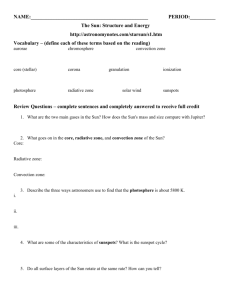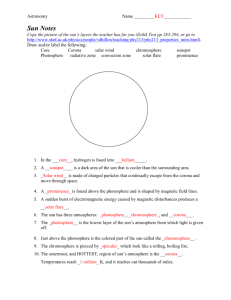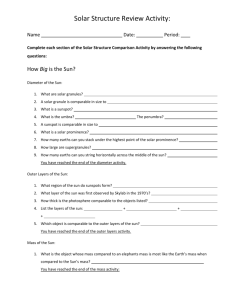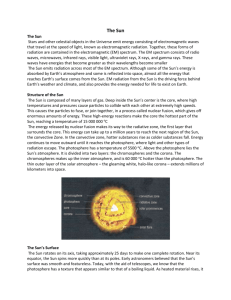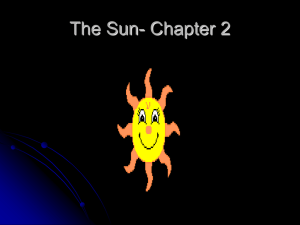The most important questions to study for the exam
advertisement
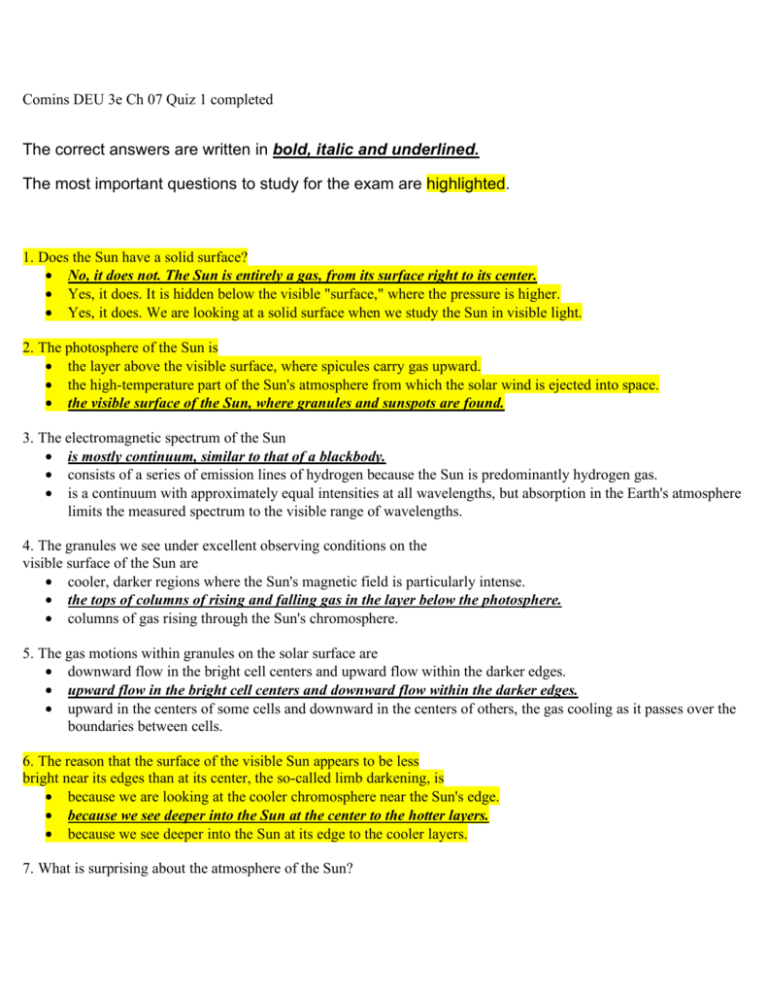
Comins DEU 3e Ch 07 Quiz 1 completed The correct answers are written in bold, italic and underlined. The most important questions to study for the exam are highlighted. 1. Does the Sun have a solid surface? • No, it does not. The Sun is entirely a gas, from its surface right to its center. • Yes, it does. It is hidden below the visible "surface," where the pressure is higher. • Yes, it does. We are looking at a solid surface when we study the Sun in visible light. 2. The photosphere of the Sun is • the layer above the visible surface, where spicules carry gas upward. • the high-temperature part of the Sun's atmosphere from which the solar wind is ejected into space. • the visible surface of the Sun, where granules and sunspots are found. 3. The electromagnetic spectrum of the Sun • is mostly continuum, similar to that of a blackbody. • consists of a series of emission lines of hydrogen because the Sun is predominantly hydrogen gas. • is a continuum with approximately equal intensities at all wavelengths, but absorption in the Earth's atmosphere limits the measured spectrum to the visible range of wavelengths. 4. The granules we see under excellent observing conditions on the visible surface of the Sun are • cooler, darker regions where the Sun's magnetic field is particularly intense. • the tops of columns of rising and falling gas in the layer below the photosphere. • columns of gas rising through the Sun's chromosphere. 5. The gas motions within granules on the solar surface are • downward flow in the bright cell centers and upward flow within the darker edges. • upward flow in the bright cell centers and downward flow within the darker edges. • upward in the centers of some cells and downward in the centers of others, the gas cooling as it passes over the boundaries between cells. 6. The reason that the surface of the visible Sun appears to be less bright near its edges than at its center, the so-called limb darkening, is • because we are looking at the cooler chromosphere near the Sun's edge. • because we see deeper into the Sun at the center to the hotter layers. • because we see deeper into the Sun at its edge to the cooler layers. 7. What is surprising about the atmosphere of the Sun? • • • Its temperature, after falling above the photosphere, rises again to reach very high values high in the atmosphere. Its temperature, after rising continuously from below the photosphere through the chromosphere, falls again suddenly in the corona. Its pressure, after dropping just above the photosphere, rises again to a value equivalent to that at the photosphere at the top of the chromosphere. 8. One interesting and somewhat unexpected characteristic of the solar corona is • its extremely high temperature, greater than 10^6 K. • its spectrum, consisting of line emissions from hydrogen, dominated by the red Balmer H? line. • its very low temperature, less than the Earth's surface temperature. This is surprising in view of its proximity to a hot radiating body, the Sun. 9. Where in the Sun's atmosphere is the temperature gradient, the rate of change of temperature with height, the highest? • In the outer corona • In the transition zone • In the photosphere 10. The average number of sunspots on the Sun • varies with a precise period of 11 years, being governed by a predictable physical process. • varies with a cycle of approximately 11 years. • does not vary much from year to year, the Sun being a very stable star. 11. The continuous spectrum of a sunspot, compared to that of the quiet solar surface, appears • somewhat redder. • somewhat more blue. • exactly the same because it is originating from the same solar material. 12. If the material at the Sun's equator is seen to rotate about the Sun's axis with a period of 25 days, what is the equivalent period of rotation for the solar polar regions? • About 18 days because this surface is closer to the solar spin axis • About 35 days, much longer than that of the equator • The same period, 25 days, because the Sun rotates as a single entity 13. Where on the Sun would you expect to see sunspots appearing at the beginning of a new cycle of sunspots? • In regions close to 10∞ N and S of the solar equator • On the equator, from which these sunspots move N and S toward the poles • In regions close to 30∞ N and S of the solar equator 14. The reason that sunspots are cooler than the photosphere is that • • • their powerful magnetic fields inhibit the convective flow of the ionized gases of the photosphere. their powerful magnetic fields act on the atoms of the photosphere to prevent them from emitting light. they are holes in the photosphere that reveal the lower temperature gases in the deeper layers. 15. The one physical parameter that transforms a region of quiet solar surface into an active and violent region is an increase in • the temperature of the gas. • the intensity of the magnetic field. • violent turbulence or convection. 16. Two pairs of associated sunspots appear on the visible disk of the photosphere of the Sun, one pair in each hemisphere. If the magnetic polarity of the westernmost spot in the northern hemisphere is found to be N, what will be the magnetic polarities of the other three spots? • The other northern spot will be N, while the two spots in the southern hemisphere will be S. • The other northern spot will be S, while in the southern hemisphere the westward spot will be S and the eastward spot will be N. • The other northern spot will be S, and the southern hemisphere spots will match this alignment; the westward spot will be N, while the eastward spot will be S. 17. How does the appearance of spectral absorption lines in the solar spectrum change when the absorbing atoms are under the influence of magnetic fields, in the so-called Zeeman effect? • Lines are shifted toward the red end of the spectrum. • The depths of the absorption lines are increased, leading to the darker appearance of sunspots on the Sun. • Lines are split into several individual lines. 18. One new and innovative method for exploring the conditions within the solar interior is the measurement of • highly penetrating gamma rays that are emitted by nuclei in the deep solar interior. • neutrons that are produced in nuclear reactions in the deep interior and that can escape from the solar plasma because they are electrically neutral. • surface oscillations that are generated by sound waves passing through the solar interior. 19. If the magnetic polarity of the northern region of the Sun were to be north in 1978, in which of the following years would it be north again? • 1989 • 2000 • Any time because the polarity of the Sun's overall magnetic field always remains the same. 20. The Maunder Minimum is a period of time • in the 1600s when sunspots were absent from the Sun. • when the Sun's radius is at a minimum during its slow oscillation in size. • between times of maximum sunspot numbers in every solar sunspot cycle.



